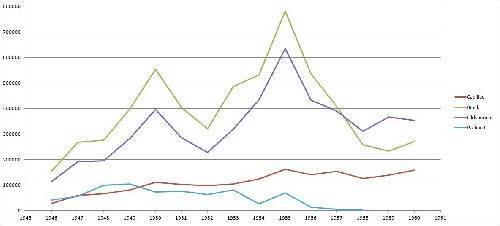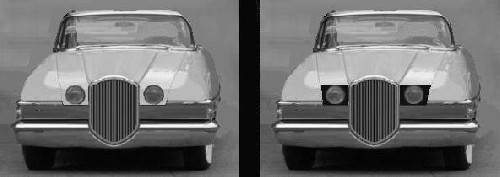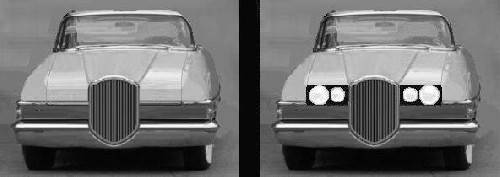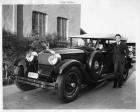|
Re: Packard & Hudson proximity
|
||||
|---|---|---|---|---|
|
Home away from home

|
More imagery to get the juices flowing. Left attempts to lengthen the hood 7 inches and meld previous grill to Predictor theme. Right updates the front fenders and hood accordingly. Single headlights would pop out immediatley to each side of grill, very 30s-ish in appearance when on but less road coverage than wide-spaced lamps. Outboard placement possible too. Chose inboard to flow the headlight doors' cut lines off the hood's cut lines for a nice unified appearance.
Can envision a smooth V12 underhood.
Posted on: 2013/2/18 20:18
|
|||
|
||||
|
Re: Packard & Hudson proximity
|
||||
|---|---|---|---|---|
|
Home away from home

|
Open headlight door themes with and without body-colored surround. A bit odd looking.
Posted on: 2013/2/18 22:25
|
|||
|
||||
|
Re: Packard & Hudson proximity
|
||||
|---|---|---|---|---|
|
Home away from home

|
Perhaps a better solution.
Posted on: 2013/2/19 7:19
|
|||
|
||||
|
Re: Packard & Hudson proximity
|
||||
|---|---|---|---|---|
|
Home away from home
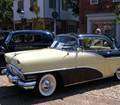
|
Mahoning:
You have concocted some interesting perspections on possible future Packard models, but I think the '55-56 Caribbean back ends were closer to the general trend of fins than the Patrician's. By 1958 to be in the same ball park as Cadillac, Packards would have needed tall fins and a wider stance than the models of 1956. Resurecting its old V-12 in the late 1950s would have seemed particularly dated, since it was obvious by now that the wavce of the future rested in the V-8, with the 6-cylinder rendered for the bottom-of-the-line, three-on-the-tree offerings.
Posted on: 2013/2/19 7:24
|
|||
|
You can make a lot of really neat things from the parts left over after you rebuild your engine ...
|
||||
|
||||
|
Re: Packard & Hudson proximity
|
||||
|---|---|---|---|---|
|
Home away from home

|
Steve made an excellent case for a Hudson tie-up. Regarding concerns over unibody costs, according to "Art of the American Automobile" Packard spent twice as much on its '48 tooling as Hudson did on its '48 step-down. From Crestline's "Packard" the '51 Packard program cost around $20-22 million. From Turnquist's book on post-war Hudson, the Jet cost $12 million. Haven't found any evidence that Hudson's unibody cost more than body on frame, rather have found the contrary. Or perhaps Hudson was simply more efficient with its spending. Either way Packard might have benefited from Hudson's cost control magic.
On the profit margins, it is true.. Packard made lots of money in the Twenties on sales in the tens rather than hundreds of thousands. But they also made $15 million in 1948 on a line-up focused on medium priced cars. Looking at the sales graph posted earlier, had Packard managed to shadow Cadillac sales from '54-60 as it had prior to that, it would have consistently sold 100,000 plus units and made a handsome profit. The same rule would have applied as the Twenties: the lower priced car paid the bills, the higher garnered the prestige (and made a nice profit). We know Barit approached Nance in summer of '53 to talk merger. That may have been a good final opportunity to combine forces. Packard's Panther concept, which came out in early '54 and was probably on the drawing boards at or soon after Barit's visit, would have been the perfect design launch point for a new step-down Packard owing to its straight-through fenders and low height. What a fabulous '55 it would have made, with a body as tight as a drum. The key to the merger would have been for Packard to be the one in control. Barit was not up to the task and the brilliant Frank Spring's occasional but disastrous design aberrations would have needed to have been kept in check. As for the Jet, a 2-door wagon and utility pick-up might have helped save it. A proper GT that fully lived up to the word Jet would have really launched the new small platform. Steve mentioned using a partial unibody, perhaps referring to the Hudson convertible's construction whereby the greenhouse was simply sawed off and 250 lbs of bracing welded to the underbody. That would have allowed a stylish hardtop greenhouse appearance across all body styles. Another possibility would have been to go with the '53 Jet's more slender unibody pillars, finished in chrome to make them look more like a hardtop. Have groused before about Mason always presenting merger plans that kept him as top dog. Had Packard merged with Hudson it would have had a luxury/medium car platform and small car and lots of dealers, and wouldn't have needed Nash. In such a scenario Nash and Studebaker would have been left to go it alone through the Fifties. Studebaker would have probably gone bankrupt by 1956. Nash would have likely focused on the Rambler but been forced to compete with an eventually redesigned and greatly improved Jet sedan, and forced to share in rather than own the small car boom that began in '58. Perhaps this may have then forced AMC to make a merger overture to Packard-Hudson at some point in the Sixties. Speaking of production, read in Kimes book that Christopher spent $25M to rebuild EGB's production line to be state of the art in material handling. Why in the world would Nance walk away from such a facility less than 10 yrs later? On the V12, agreed it would have been out of place and in early '56 the last thing Packard needed to focus its scant resources on. As folks in this forum have taught me, big OHV V8s had all the power a car needed and good smoothness, and Packard's V8 apparently had potentially 440 CIDs in it. A V12 based on the 320 V8 would have had 480 CID, not much more than the 440. And yet... that sweet sound of a V12 and its sweet marketing copy! It would have been an act of passion. On the fins, someone high up in Packard design needed to threaten to quit - and take half the design department with him - if mgmt forced them to add fins. Packard needed to stay Packard. Timeless, tailored, oozing with prestige, snobby. Nance used the term "architecturally correct." Same.
Posted on: 2013/2/19 19:58
|
|||
|
||||
|
Re: Packard & Hudson proximity
|
||||
|---|---|---|---|---|
|
Forum Ambassador

|
Quote:
Speaking of production, read in Kimes book that Christopher spent $25M to rebuild EGB's production line to be state of the art in material handling. Why in the world would Nance walk away from such a facility less than 10 yrs later? Glad you asked. I don't believe the reasons have ever been sufficiently researched. I wonder if there's a single published Packard "historian" who ever set foot in an automotive stamping and fabrication plan. (I have.) I can only think of one who might have any idea of the infrastructure (including below grade) required for all those massive presses. I'm no MBA, but have a strong gut feeling that Packard management found that relocating all the necessary equipment from Conner to E. Grand simply wasn't feasible, in terms of time as well as money. On the other hand, I wonder, since the 55-56 restyle is reported to have been a stop-gap measure to allow time to develop the intended 57 line, if the move to Conner might have been intended to allow for refitting of the E. Grand facility to allow for production of the all-new chassis and body for the 57s. Yet, in view of the greater shared-body concept for S-P and the fact that Studebaker's had it's own stamping facility, perhaps they intended to consolidate production in South Bend after the end of the 56th Series production run - well in advance of the Curtiss-Wright plan. Regardless, the minute that Chrysler acquired Briggs, Packard's days were numbered.
Posted on: 2013/2/19 21:28
|
|||
|
||||
|
Re: Packard & Hudson proximity
|
||||
|---|---|---|---|---|
|
Forum Ambassador
|
I seem to recall more than one article mentioning that EGB production had been decided against after Nance was heavily lobbied & convinced by his "team" that old multi story buildings like EGB were too inefficient to make cars at a profit much longer.
The theory was the only way to build and plan for the future production was in single story buildings and that was why Connor was heavily promoted by vice president of operations, Ray Powers.
Posted on: 2013/2/19 22:29
|
|||
|
Howard
|
||||
|
||||
|
Re: Packard & Hudson proximity
|
||||
|---|---|---|---|---|
|
Home away from home

|
Gee, one of those dream Packards kinda looks like Turnquist.
Maybe the ad copy would read "An invitation to the independently wealthy"
Posted on: 2013/2/19 23:51
|
|||
|
||||
|
Re: Packard & Hudson proximity
|
||||
|---|---|---|---|---|
|
Home away from home

|
Hi
EGB was prefectly fit to continue production and final assembly in after Connor Avenue was leased from Briggs for bodybuilding and only that. It was only the singularly bad advice from Ray Powers and Nance's lack of manufacturing experience that set the headlong rush to cram everything except engine and transmission production into that crackerbox. JJN didn't stop at shaking up the products they were producing, he just had to shake up the facilities they were produced in as well. The actions on the former were absolutely necessary, on the latter they became the set-up for disaster for those very '55's and '56's so critical to floating them over the rough patch to all-new cars. Steve
Posted on: 2013/2/20 8:36
|
|||
|
||||

 (40.79 KB)
(40.79 KB)